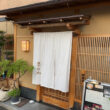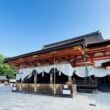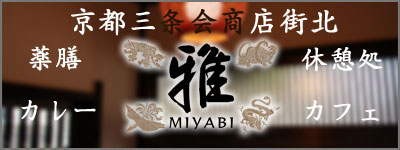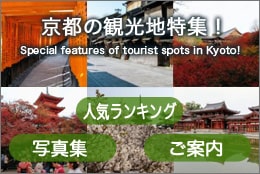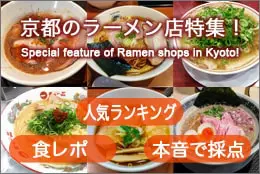At first glance, it seems intimidating—“Kawamichiya Yoro”
Posted date:2025-09-24Author:つばくろ(Tsubakuro) Transrator:ポンタ(Ponta)
Category:Kyoto Gourmet , Talk about Kyoto
広告
adsense4
At first glance, it seems a bit expensive…
Enjoying the signature dish “Yoro Nabe” at Kawamichiya Yoro, actually a long-established soba restaurant you can trust.
To begin with
It’s located 10-minute walk from the bus stop “In front of Kumano Shrine” of Seigo-in in Sakyo Ward.
It’s a long-established soba restaurant quietly nestled in a quiet residential area, not far from places like Shogo-in gate remains and Heian Shrine.
Standing before the restaurant, one is inevitably overwhelmed by its refined and elegant charm, causing anyone to hesitate involuntarily.
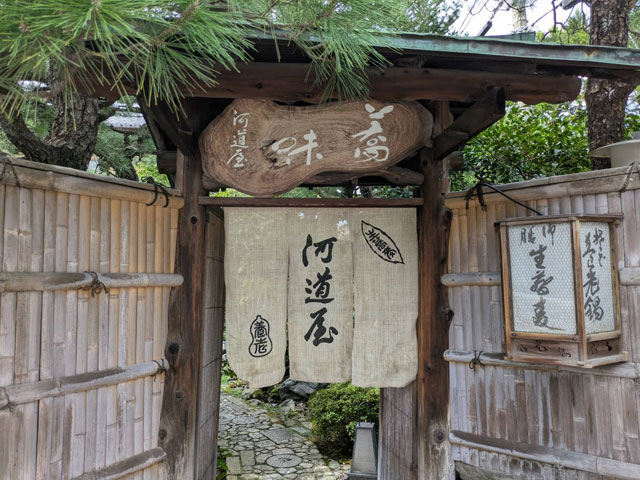
The entrance of Kawamichiya Yoro.
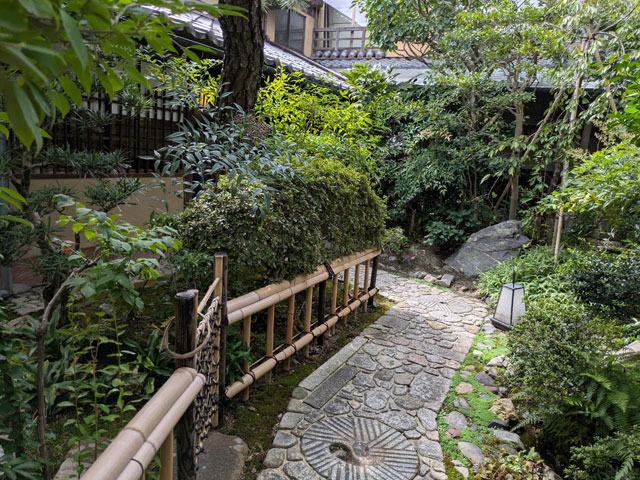
The stone-paved path just inside the entrance
You might wonder if you’ve accidentally stepped into a high-end restaurant – it has that kind of atmosphere that makes you brace yourself. But don’t worry about the price at all; it’s a down-to-earth, affordable soba restaurant with very reasonable prices.
hat is Kawamichiya Yoro, a long-established soba restaurant representing Kyoto, founded in 1910, which I introduce today.
Enjoy the signature dish Yoro Hotpot
A Kyoto townhouse over 150 years old, relocated from a farmhouse by the Shirakawa River, warmly welcomes you.
After taking off your shoes, the wooden-floored hallway leads to the inner tatami room.
In the back tatami room, several slightly lower tables were arranged in a single space, each pre-equipped with a gas stove.
The standard style is to sit on tatami mats while eating, but for those who find sitting uncomfortable, rooms with sunken kotatu tables are also available.
Well, the columnist was also shown into the room with the sunken kotatu.
As I stretched my legs out on the kotatu and relaxed, the menu the hostess showed me listed the standard soba dishes in a long row.
Bamboo-basket soba (900-yen), Chicken steamed soba (900-yen), Grated radish soba (880-yen), Chicken nanban (1000-yen), Tempura bamboo-basket soba (1,600-yen), Herring soba (1,300-yen).
You can rest assured that the prices on every menu item are easy on the wallet.
I could hear the voices of the customers in the next room, so listening to them, I found they had ordered herring soba and tempura bamboo-basket soba.
Well, this time, the columnist ordered the restaurant’s specialty, the Yoro hotpot (4,200-yen).
Yoro hotpot refers to soba-suki, a dish distinct from udon-suki, where Kyoto specialties like yuba, fresh fu, and hirousu are combined with local chicken, shrimp, Kujo green onion, and other Kyoto vegetables, briefly simmered, and finished by enjoying soba noodles and kishimen.
This dish features Kyoto-style light broth simmered with ingredients unique to Kyoto. Once the broth’s umami reached its peak, kishimen and soba noodles are added to enjoy.
As I sat down in the tatami room and gazed at the garden view, hostess brought over the ingredients for the hotpot.
At first glance, it looked like this.
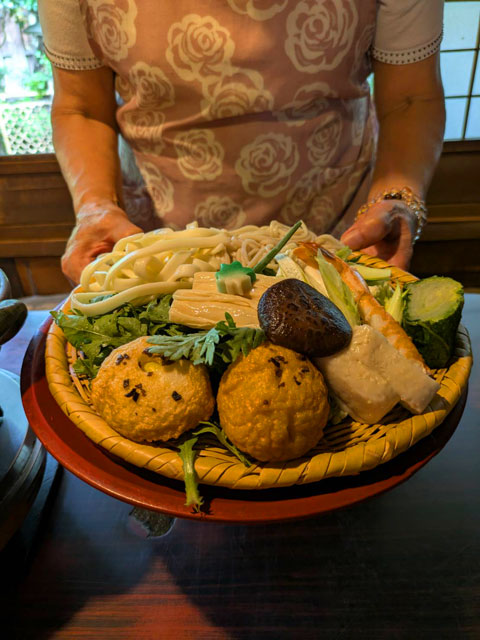
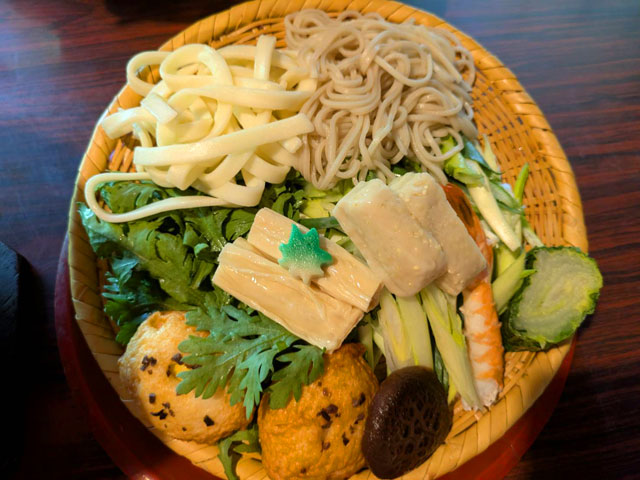
From the right: Chinese cabbage, shrimp, Kujo green onions, shiitake mushrooms, hirousu, fresh fu, yuba, maple-leaf fu, chrysanthemum greens, soba noodles, and kishimen noodles.
Also, the ingredients in this hotpot include yuba from the long-established Yuba-Han, fresh fu from Fuka with its uniquely chewy texture, and hirousu from Izuman that enhance the pot’s umami flavor.
It’s quite the parade of Kyoto specialties, isn’t it?
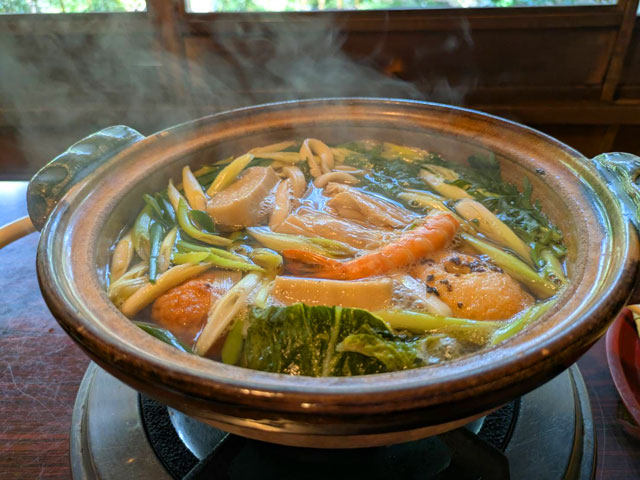
Just like with udon suki, start by eating the ingredients first.
Scoop the ingredients onto a side plate and enjoy them with lemon and shichimi pepper and the refined Kyoto-style broth is mellow and spreads its flavor throughout your mouth.
What impressed me most was how well the hirousu and dashi complemented each other.
I can only say I was truly impressed by this pairing.
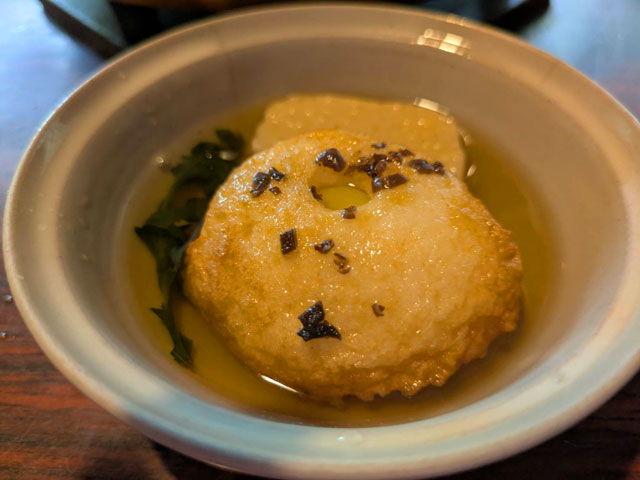
The hirousu in the side plate
Finally, the kishimen and soba noodles are added.
This restaurant’s soba noodles are characteristically pale for some reason.
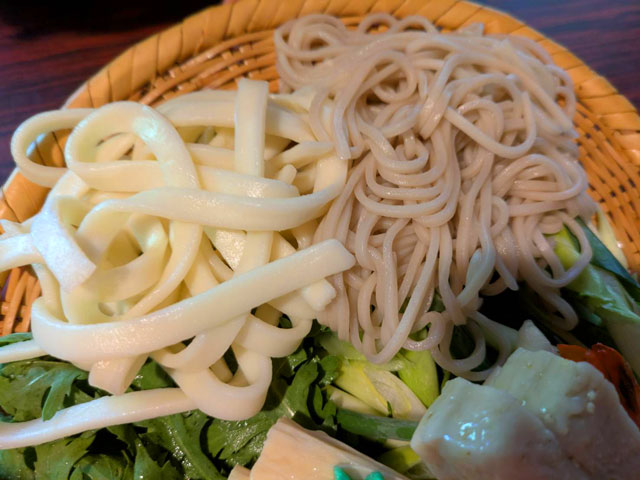
Soba noodles and kishimen
Unlike Shinshu soba, this Kyoto-style noodle has a smooth, slippery texture that glides down the throat, and it pairs wonderfully with the flavorful broth of the hotpot.
Though the day the columnist visited was still sweltering hot, the Yoro hotpot I ate while panting was truly exceptional.
Many customers in the adjacent tatami room were eating tempura bamboo-basket soba or herring soba,
but even if it’s hot or a bit pricy, I highly recommend ordering the signature Yoro hotpot when you visit this restaurant.
It never betrays your expectation.
Hear the Inside Story of the Restaurant from the Owner and Mother
After finishing the hotpot, I had a long talk with the owner and mother.
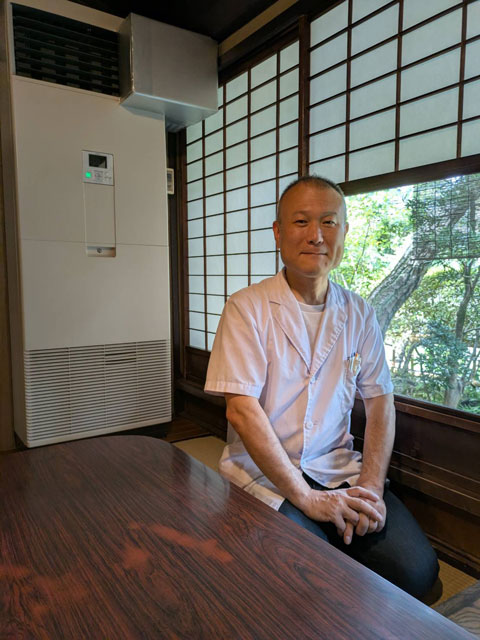
The restaurant’s owner
First, I asked the fourth-generation owner.
“Our restaurant was founded in 1910, and we’ve been making noodles for a long time. We opened our soba restaurant in 1962. Our signature dish, the Yoro hotpot, has been on the menu since then. My grandfather, the second-generation owner, consulted with various chefs through the cooking association about the broth and ingredients that would pair well with soba, and that’s how this hotpot came to be.”
“The characteristics of our soba?” Nothing particularly special, really. Our noodles have been machine-made since the founding days.”
“Is the soba prepared to complement the flavor of the Yoro hotpot?”
“No, we’ve never made soba specifically with Yoro hotpot in mind.”
“I’m the fourth-generation owner. Customers who come here often praise our low prices, but we’re just a family-run restaurant after all… Well, we run the restaurant with the mindset that as long as my family can somehow make ends meet, that’s good enough. We don’t really plan to raise prices much.
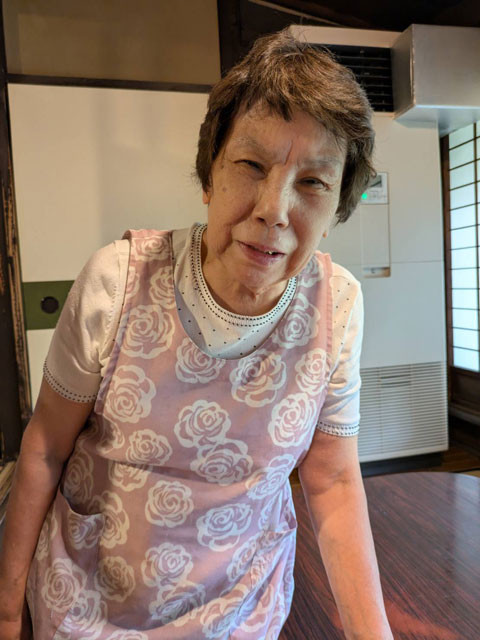
The mother in charge of managing the restaurant
Next, I’ll hear from the mother responsible for attending to customers.
“Our family started the soba restaurant in 1962, as my son just mentioned. This place was where our family lived until then. In this house. This dwelling was originally relocated from a farmhouse by the Shirakawa River. It’s over 150 years old. People often tell us our garden has a certain charm, but it’s just a simple home, and we’ve only ever tended it as one would any ordinary garden. His Imperial Highness Price Takamatu visited in 1965. While touring the Shogo-in Monzeki temple grounds, he stopped by our restaurant for a meal.
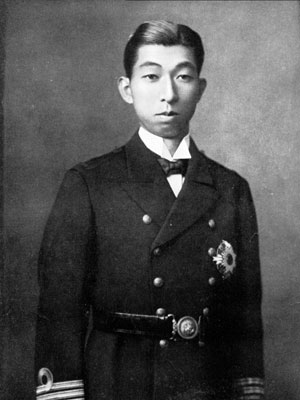
His Imperial Highness Prince Takamatu
“Akira Kurosawa and Shintaro Katu were frequentl visitors, too. But you know, we’re just a family business, after all.”
“Where do most of the customers come from?”
“Within Japan, it’s probably the Kanto region. We had more overseas customers before the pandemic. We originally made noodles, you see. We were granted permission to branch off from the Kawamichiya, a shop that’s been around since the Edo period. We started the soba restaurant more recently. We’re the only one serving Yoro hotpot. The original restaurant doesn’t offer it. But we don’t make soba-bolos either.
The mother showed me around the restaurant.
The courtyard garden, the stone-paved entrance, the view of the garden from the tatami room.
Each and every one of these traditional townhouses, steeped in history and steeped in tradition, has a charm that makes your heart feel warm and relaxed.
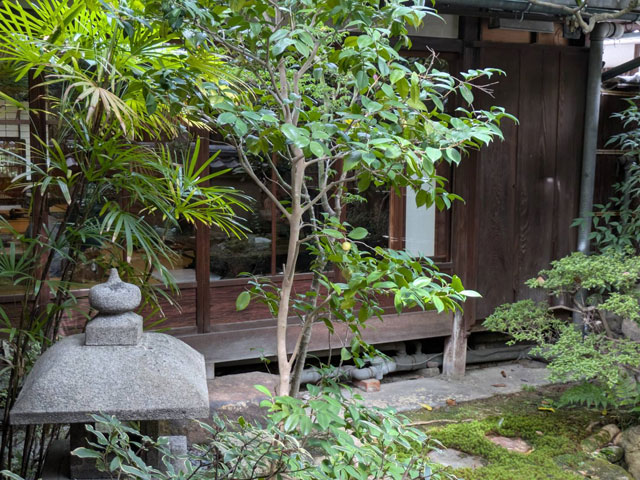
The courtyard garden
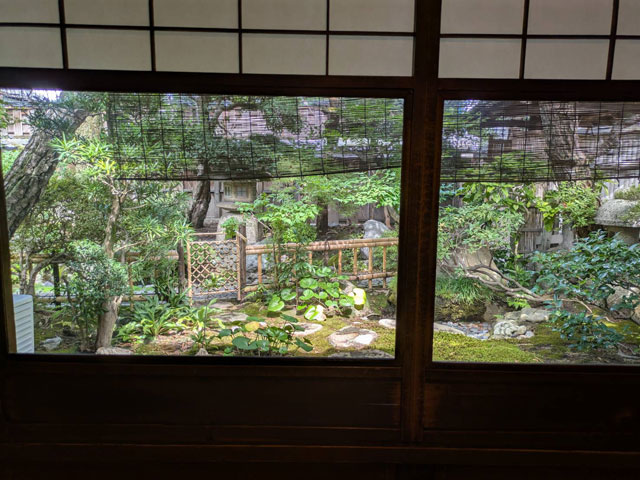
Viewing the garden from the tatami room
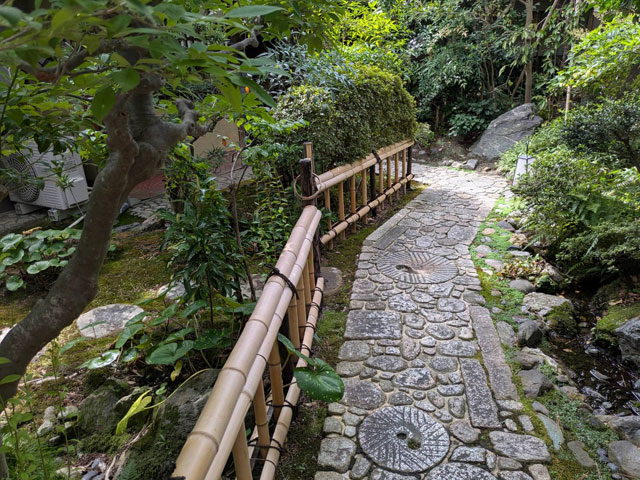
The stone-paved entrance
The conclusion
This restaurant seems perfect for introducing to people who aren’t very familiar with Kyoto. Its location away from the hustle and bustle, its charming exterior embodying the quintessential image of Kyoto, and the furnishings of each tatami room.
Moreover, the down-to-earth pricing is truly appreciated – a rare find these days.
I myself have taken friends from Germany and Austria to this restaurant many times when they visited Kyoto.
I can confidently recommend it as the perfect place to take friends who don’t know Kyoto, whether they’re foreigners or locals from Osaka or Kobe.
Moreover, it’s a place where you can’t help but warm to the character of the fourth-generation owner and his mother, who handles customers service.
The two are refreshingly pleasant, kind, and always smiling – truly impressive.
The restaurant information
〒606-8391
Kyoto City Sakyo Ward Seigo-in Nishi town 1-1
Kawamichiya Yoro
TEL: 075-771-7531
Business hours: 11:00 – 19:00
Regular holidays: Tuesdays
About reservation: Not particularly necessary
Transportation access:
10-minute walk from Kyoto City Bus stop “In front of the Kumano Shrine”
Author
つばくろ(Tsubakuro)
I was born and raised in Kyoto and am a native Kyotoite.
When I was young, I longed to visit Tokyo and Osaka, which are more bustling than Kyoto, but as I have gotten older, I have come to appreciate Kyoto a little more.
In this site, I will introduce you to some of the best places to explore Kyoto's food that you might otherwise miss at first glance.



